Experimental Investigation of the Steady-State Flow Field with Particle Image Velocimetry on a Nozzle Check Valve and Its Dynamic Behaviour on the Pipeline System
Abstract
:1. Introduction
2. Experimental Setup
2.1. Experimental Aims and Methods
2.2. Experimental Principles
2.2.1. Principle of PIV Flow Velocity Measurement
2.2.2. Principle of Dynamic Characteristics Testing
2.3. Experimental System and Process
3. Results and Discussion
3.1. Nozzle Check Valve Static Characteristics and Flow Field Analysis
3.1.1. Static Characteristics Analysis
3.1.2. Flow Field Analysis
3.2. Nozzle Check Valve Dynamic Behavior Analysis
4. Conclusions
Author Contributions
Funding
Institutional Review Board Statement
Informed Consent Statement
Conflicts of Interest
References
- Karpenko, M.; Prentkovskis, O.; Šukevičius, Š. Research on high-pressure hose with repairing fitting and influence on energy parameter of the hydraulic drive. Eksploat. Niezawodn.-Maint. Reliab. 2022, 24, 25–32. [Google Scholar] [CrossRef]
- Urbanowicz, K.; Bergant, A.; Kodura, A.; Kubrak, M.; Malesińska, A.; Bury, P.; Stosiak, M. Modeling transient pipe flow in plastic pipes with modified discrete bubble cavitation model. Energies 2021, 14, 6756. [Google Scholar] [CrossRef]
- Sibilla, S.; Gallati, M. Hydrodynamic characterization of a nozzle check valve by numerical simulation. J. Fluids Eng. 2008, 130, 121101. [Google Scholar] [CrossRef]
- Botros, K.K.; Richards, D.J.; Roorda, O. Effect of check valve dynamics on the sizing of recycle systems for centrifugal compressors. In Proceedings of the ASME 1996 International Gas Turbine and Aeroengine Congress and Exhibition, Birmingham, UK, 10 June 1996; American Society of Mechanical Engineers: New York, NY, USA, 1996. [Google Scholar]
- Lai, Z.; Li, Q.; Karney, B.; Yang, S.; Wu, D.; Zhang, F. Numerical Simulation of a Check Valve Closure Induced by Pump Shutdown. J. Hydraul. Eng. 2018, 144, 06018013. [Google Scholar] [CrossRef]
- Li, G.; Liou, J.C.P. Swing check valve characterization and modeling during transients. In Proceedings of the ASME/JSME 2003 4th Joint Fluids Summer Engineering Conference, Honolulu, HI, USA, 6–10 July 2003; Volume 1: Fora, Parts A, B, C, and D, pp. 2839–2846. [Google Scholar]
- Guivier-Curien, C.; Deplano, V.; Bertrand, E. Validation of a numerical 3-D fluid–structure interaction model for a prosthetic valve based on experimental PIV measurements. Med. Eng. Phys. 2009, 31, 986–993. [Google Scholar] [CrossRef] [PubMed]
- Corvaro, F.; Marchetti, B.; Vitali, M. Validation of velocity field measured with particle image velocimetry of a partially heated cavity. Heat Transf. Eng. 2022, 1–3. [Google Scholar] [CrossRef]
- Capanna, R.; Bardet, P.M. High speed PIV measurements in water hammer. In Proceedings of the 14th International Symposium on Particle Image Velocimetry, Online, 1–4 August 2021. [Google Scholar]
- Dobrev, I.; Massouh, F. CFD and PIV investigation of unsteady flow through Savonius wind turbine. Energy Procedia 2011, 6, 711–720. [Google Scholar] [CrossRef] [Green Version]
- Shen, L.; Willman, C.; Stone, R.; Lockyer, T.; Magnanon, R.; Virelli, G. On the use of particle image velocimetry (PIV) data for the validation of Reynolds averaged Navier-Stokes (RANS) simulations during the intake process of a spark ignition direct injection (SIDI) engine. Int. J. Engine Res. 2022, 23, 1061–1081. [Google Scholar] [CrossRef]
- Provoost, G.A. The Dynamic Behavior of Non-Return Valves. In Proceedings of the Third International Conference on Pressure Surges, Canterbury, UK, 25–27 March 1980. [Google Scholar]
- Thorley, A.R.D. Check Valve Behavior Under Transient Flow Conditions: A State-of-the-Art Review. J. Fluids Eng 1989, 111, 178–183. [Google Scholar] [CrossRef]
- Botros, K.K. Spring stiffness selection criteria for nozzle check valves employed in compressor stations. J. Eng. Gas Turbines Power 2011, 133, 122401. [Google Scholar] [CrossRef]
- Rao, P.V.; Achar, K.R.T.; Rao, P.L.N.; Purcell, P.J. Case study of check-valve slam in rising main protected by air vessel. J. Hydraul. Eng. 1999, 125, 1166–1168. [Google Scholar] [CrossRef]
- Yang, Z.; Zhou, L.; Dou, H.; Lu, C.; Luan, X. Water hammer analysis when switching of parallel pumps based on contra-motion check valve. Ann. Nucl. Energy 2020, 139, 107275. [Google Scholar] [CrossRef]
- Kim, N.S.; Jeong, Y.H. An investigation of pressure build-up effects due to check valve’s closing characteristics using dynamic mesh techniques of CFD. Ann. Nucl. Energy 2020, 152, 107996. [Google Scholar] [CrossRef]
- Wang, H.M.; Chen, S.; Li, K.L.; Li, H.Q.; Yang, Z. Numerical study on the closing characteristics of a check valve with built-in damping system. J. Appl. Fluid Mech. 2021, 14, 1003–1014. [Google Scholar]
- Mk, A.; Ak, B.; Es, B. Analytical and CFD analysis investigation of fluid-structure interaction during water hammer for straight pipe line. Int. J. Press. Vessel. Pip. 2021, 194, 104528. [Google Scholar]
- Lai, Z.; Karney, B.; Yang, S.; Wu, D.; Zhang, F. Transient performance of a dual disc check valve during the opening period. Ann. Nucl. Energy 2017, 101, 15–22. [Google Scholar] [CrossRef]
- Himr, D.; Habán, V.; Hudec, M.; Pavlík, V. Experimental investigation of the check valve behaviour when the flow is reversing. EPJ Web Conf. 2017, 143, 02036. [Google Scholar] [CrossRef] [Green Version]
- Himr, D.; Habán, V.; Hudec, M. Experimental investigation of check valve behaviour during the pump trip. J. Phys. Conf. Ser. 2017, 813, 012054. [Google Scholar] [CrossRef] [Green Version]
- Himr, D.; Habán, V.; Závorka, D. Axial check valve behaviour during flow reversal. IOP Conf. Ser. Earth Environ. Sci. 2019, 405, 012012. [Google Scholar] [CrossRef]
- Westerweel, J. Fundamentals of digital particle image velocimetry. Meas. Sci. Technol. 1997, 8, 1379. [Google Scholar] [CrossRef] [Green Version]
- Clément, S.A.; André, M.A.; Bardet, P.M. Multi-spatio-temporal scales PIV in a turbulent buoyant jet discharging in a linearly stratified environment. Exp. Therm. Fluid Sci. 2021, 129, 110429. [Google Scholar] [CrossRef]
- Pérez, J.M.; Sastre, F.; Le Clainche, S.; Vega, J.M.; Velazquez, A. Three-dimensional flow field reconstruction in the wake of a confined square cylinder using planar PIV data. Exp. Therm. Fluid Sci. 2022, 133, 110523. [Google Scholar] [CrossRef]
- Gu, M.; Li, J.; Xu, C. A modified Richardson–Lucy deconvolution for rapid reconstruction of light field μPIV. Exp. Fluids 2022, 63, 1–15. [Google Scholar] [CrossRef]
- Pastrana, H.; Treviño, C.; Pérez-Flores, F.; Martínez-Suástegui, L. TR-PIV measurements of turbulent confined impinging twin-jets in crossflow. Exp. Therm. Fluid Sci. 2022, 136, 110667. [Google Scholar] [CrossRef]
- Joukowsky, N. Über den Hydraulischen Stoss in Wasserleitungsrohren; Series 8; Mémoires de l’Académie Impériale des Sciences: St.-Pétersbourg, Russia, 1900. [Google Scholar]
- Thorley, A.R.D. Fluid Transients in Pipeline Systems; D&L George Ltd.: Herts, UK, 1991. [Google Scholar]
- Ballun, J.V. A methodology for predicting check valve slam. Am. Water Work. Assoc. 2007, 99, 60–65. [Google Scholar] [CrossRef]
- Sra, B.; Ar, A. Experimental investigation of viscoelastic turbulent fluid hammer in helical tubes, considering column-separation. Int. J. Press. Vessel. Pip. 2021, 194, 104489. [Google Scholar]
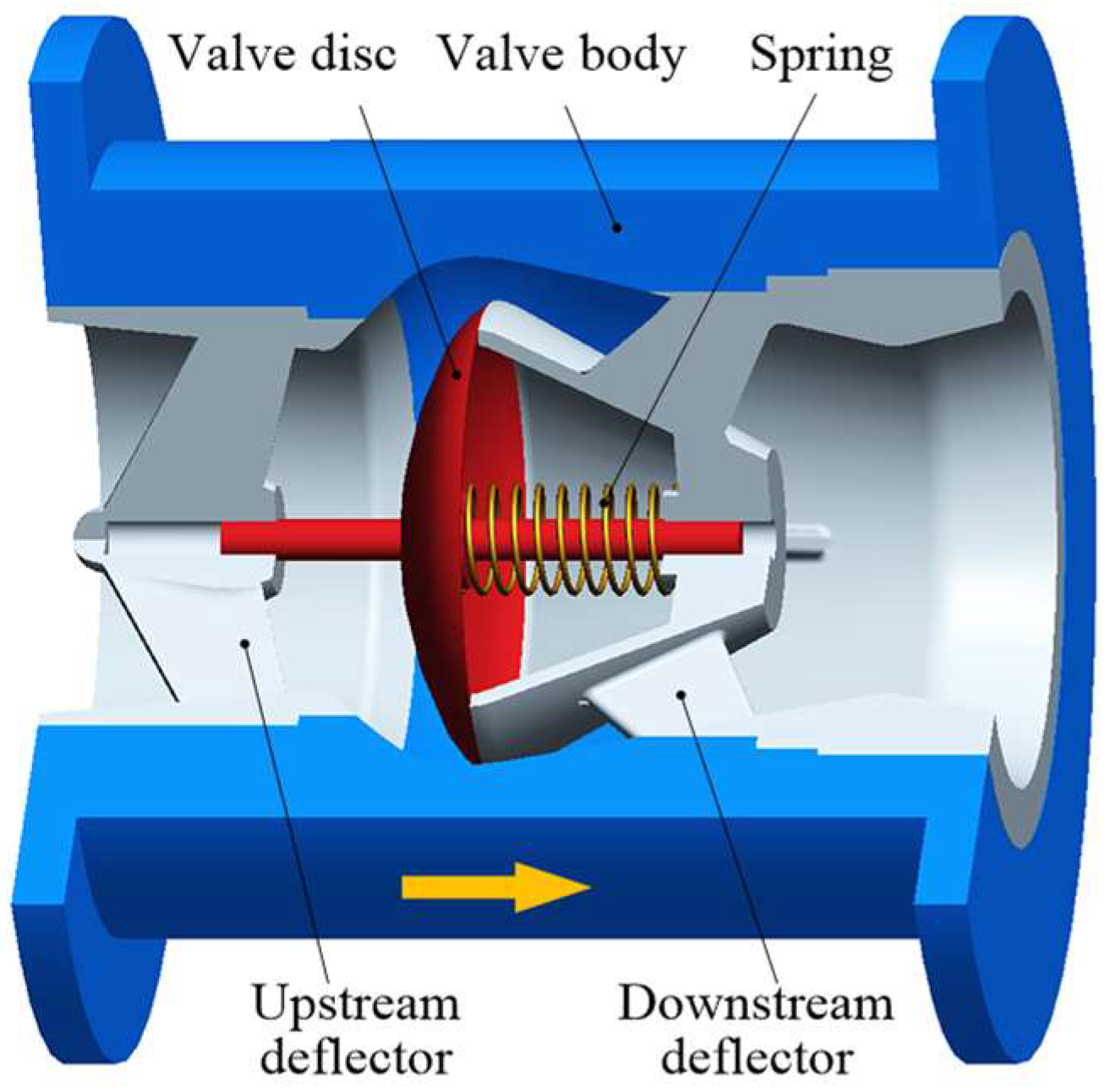

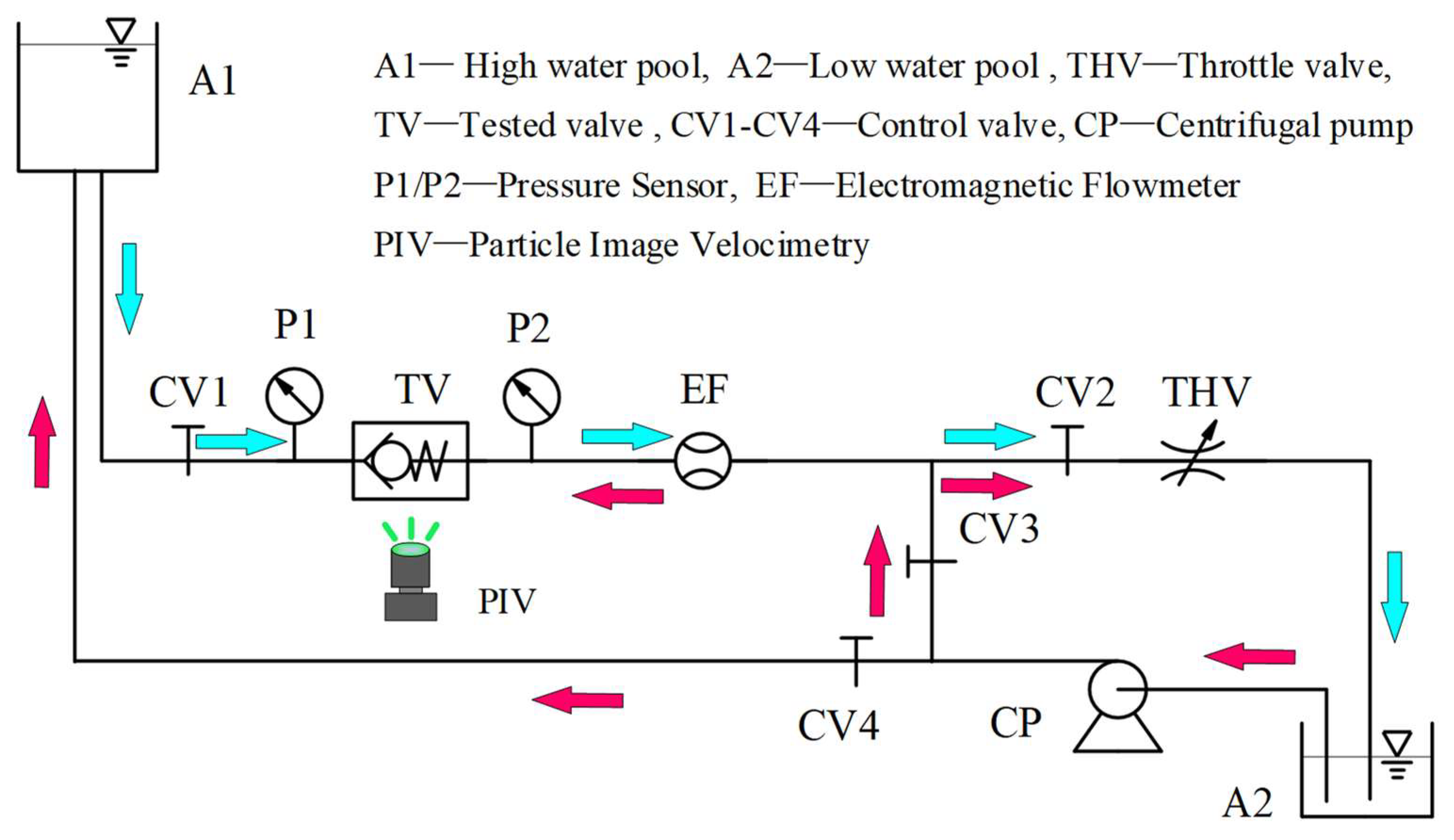
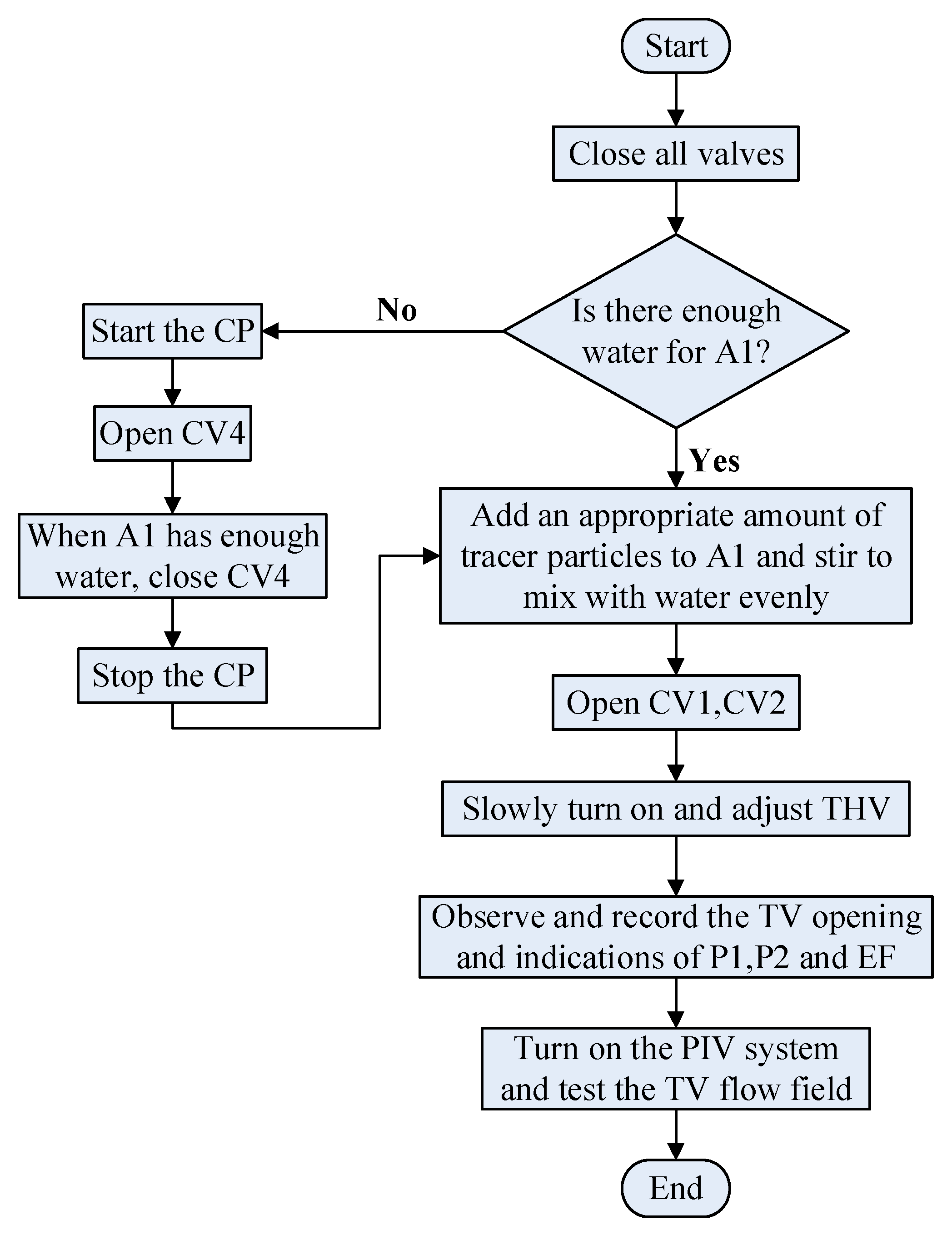
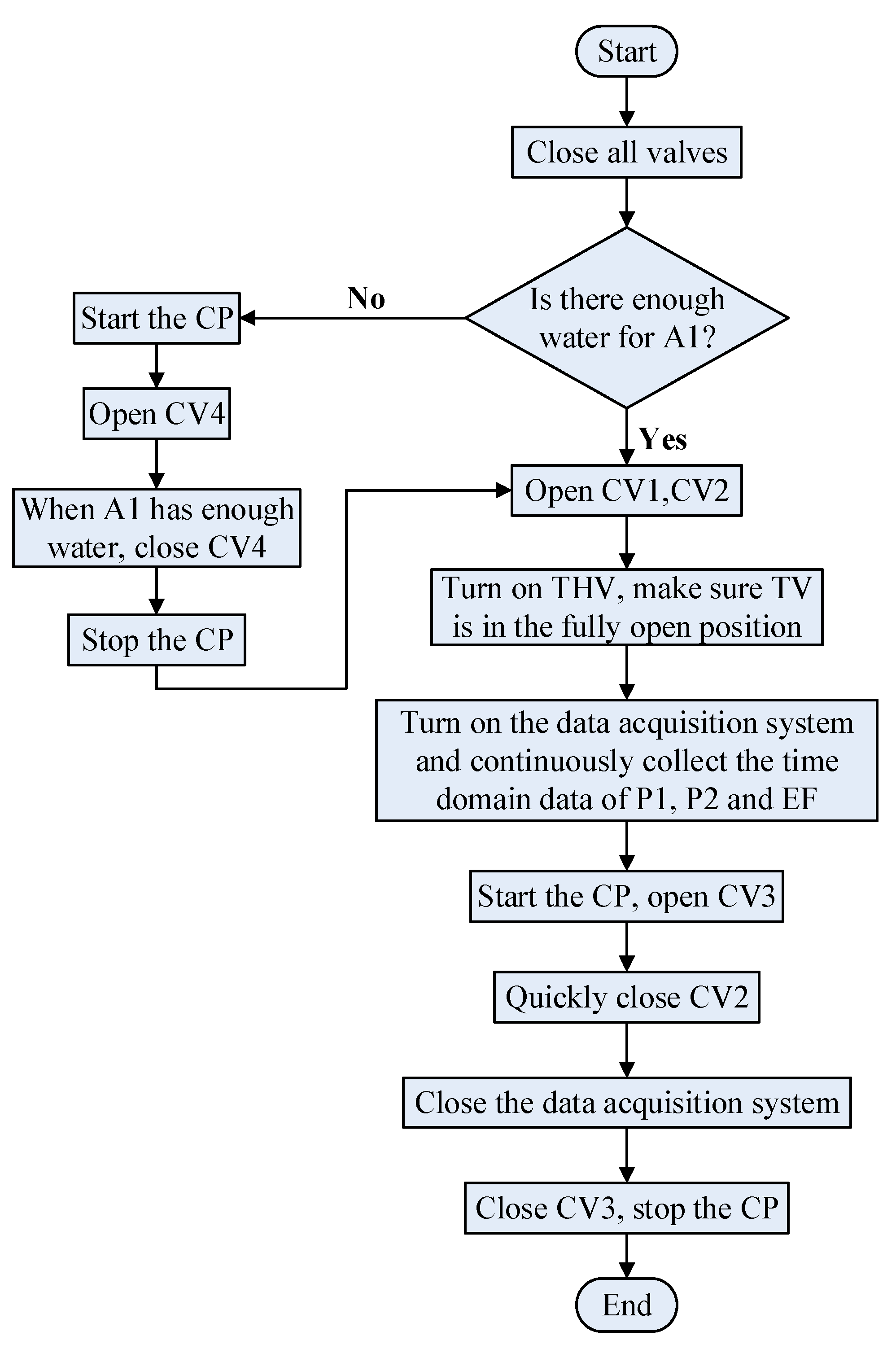

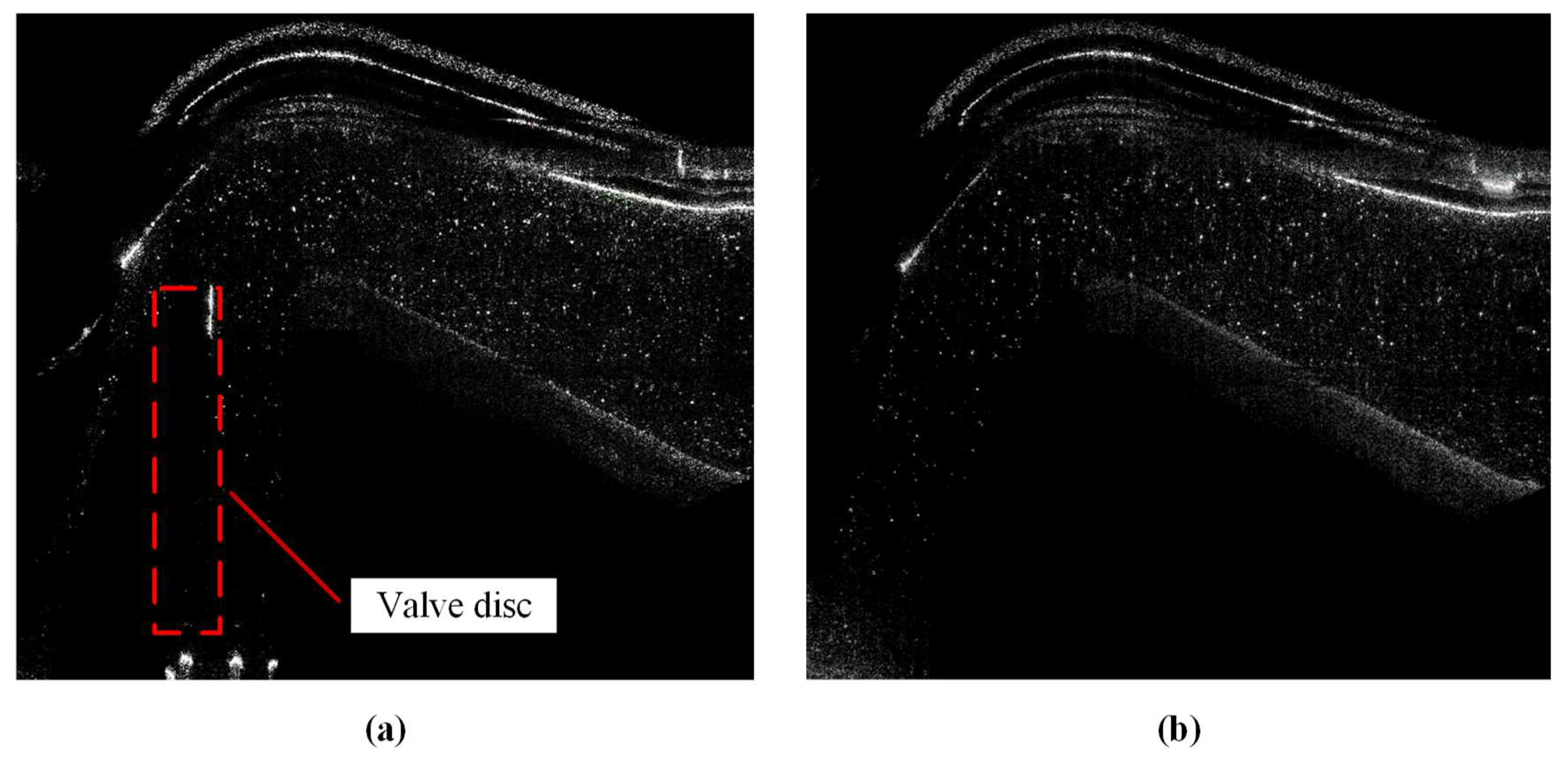
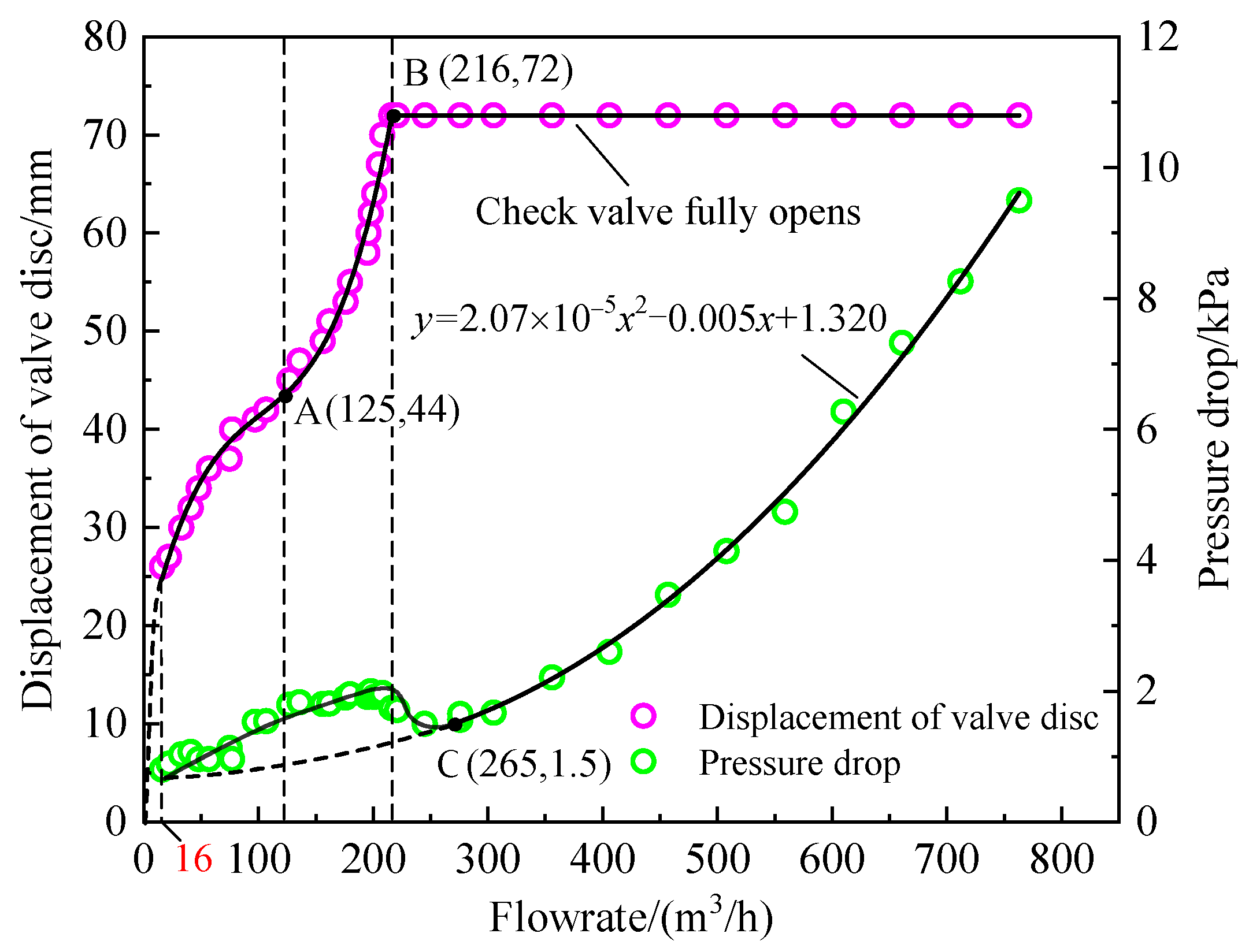
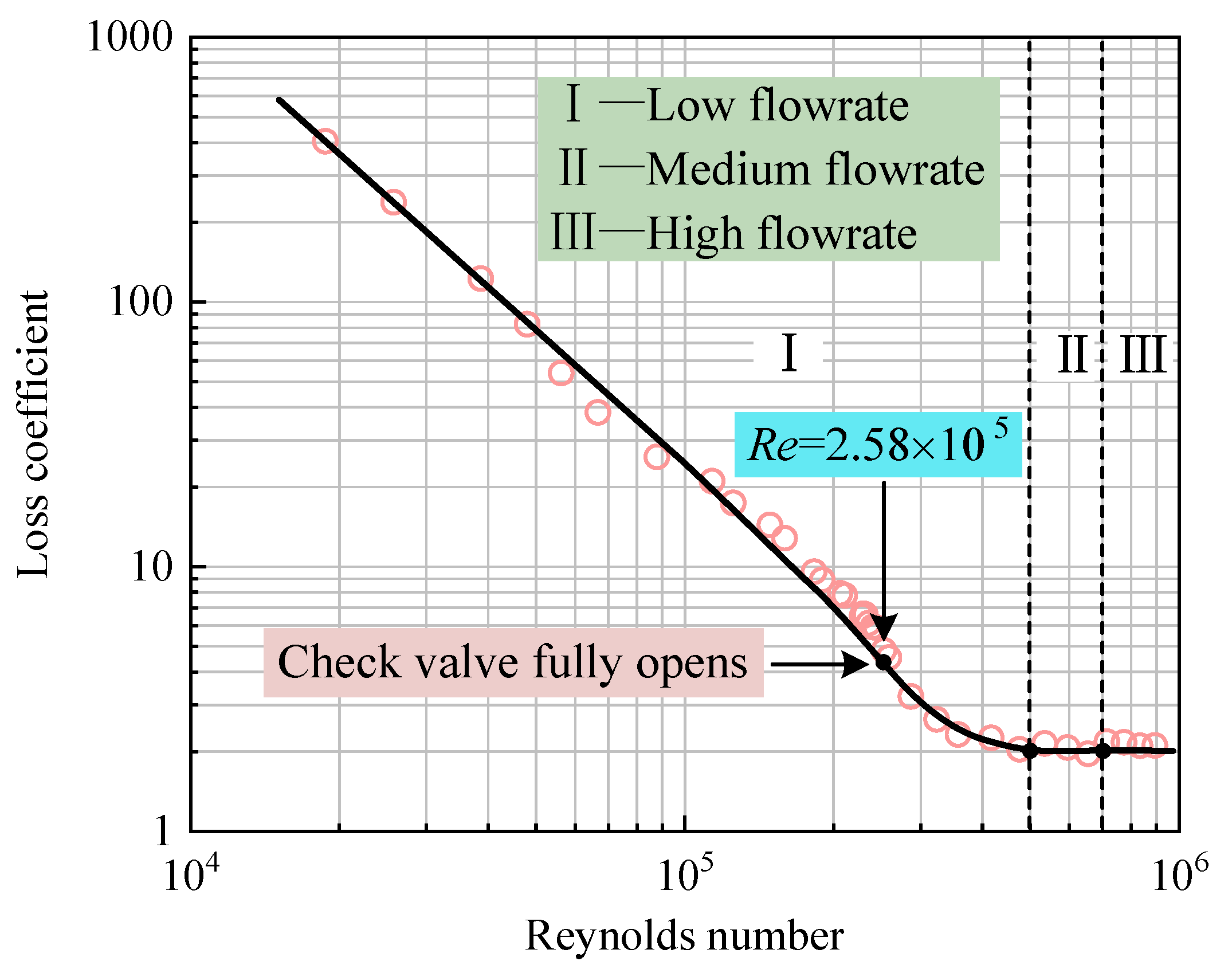

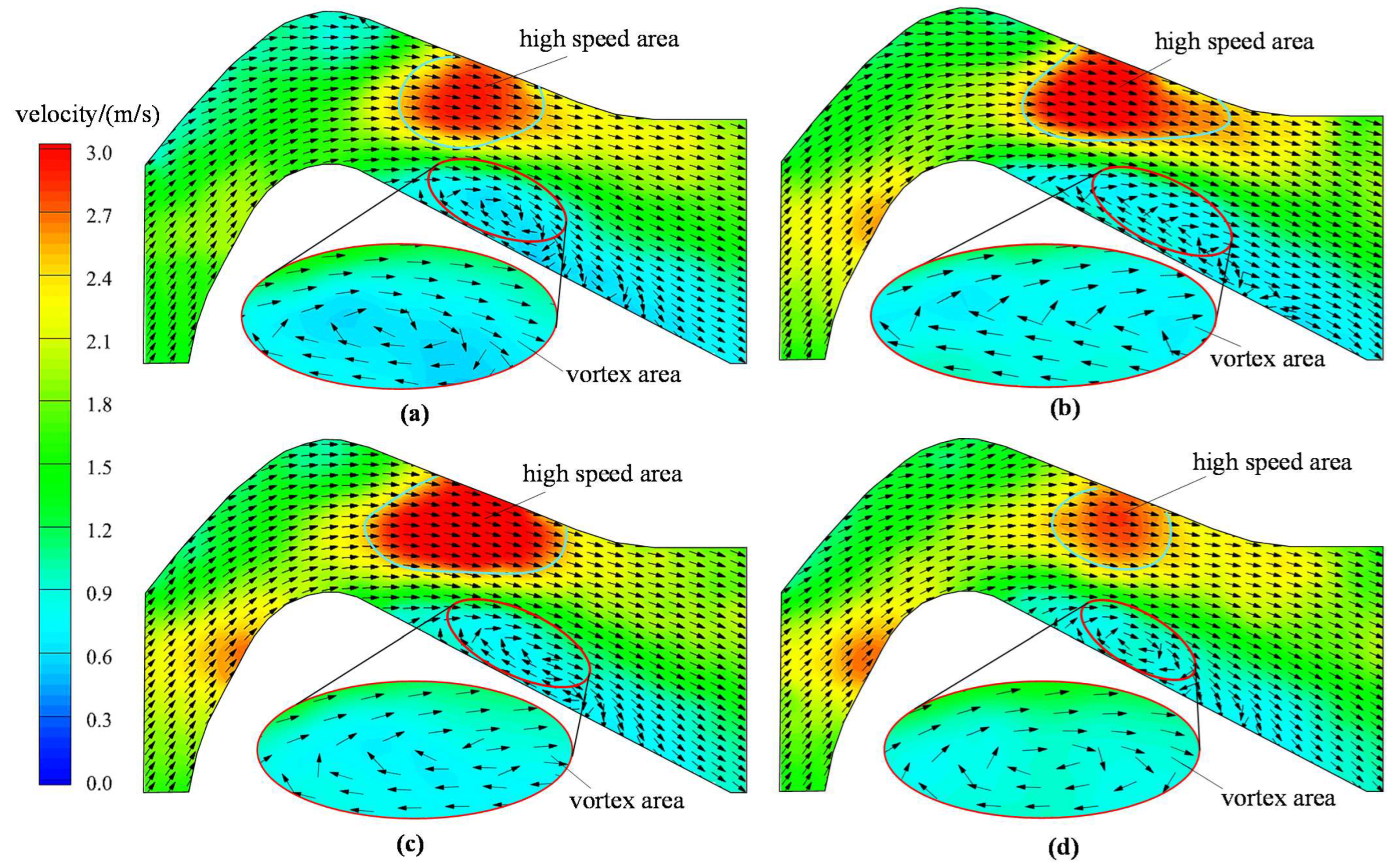
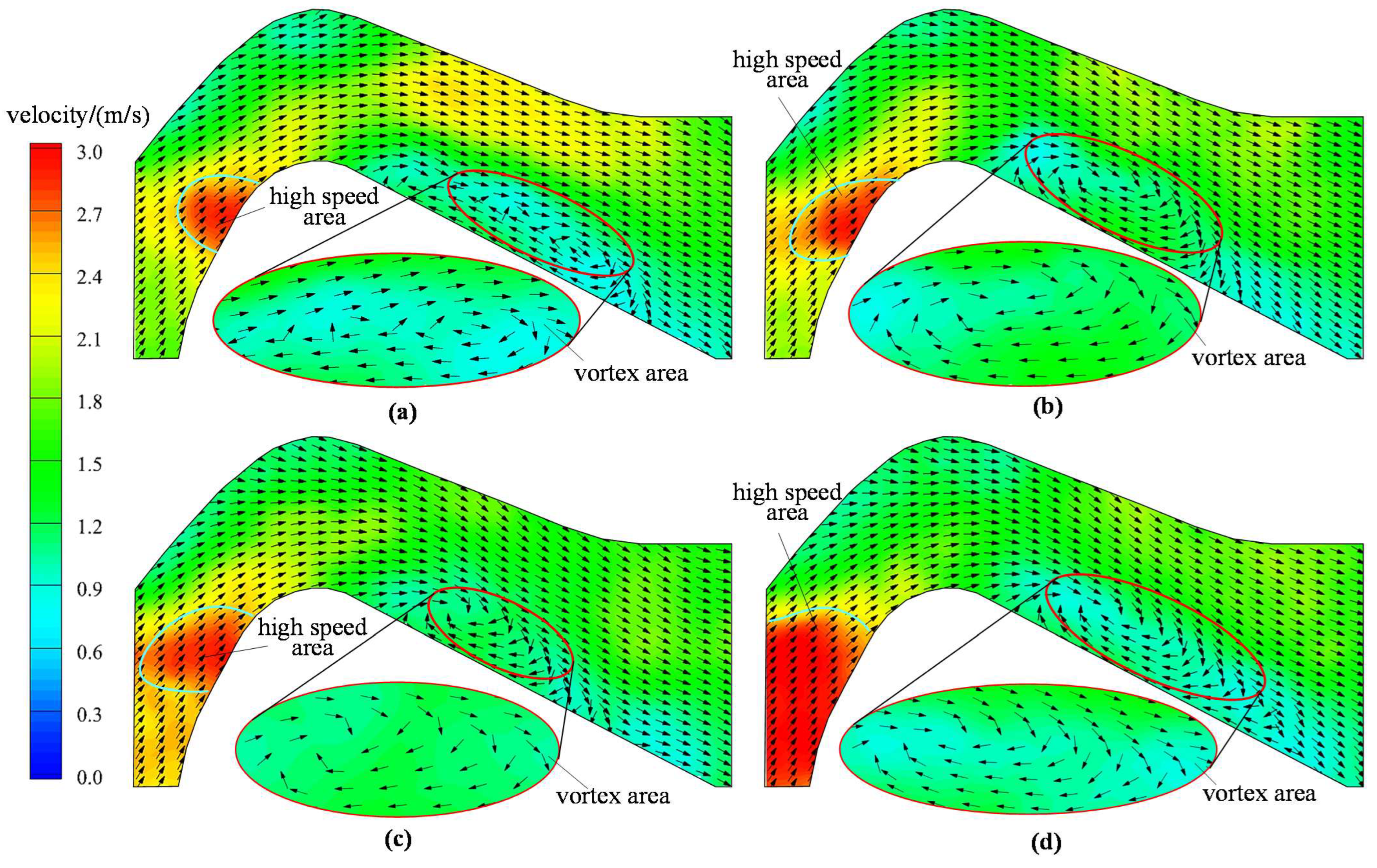
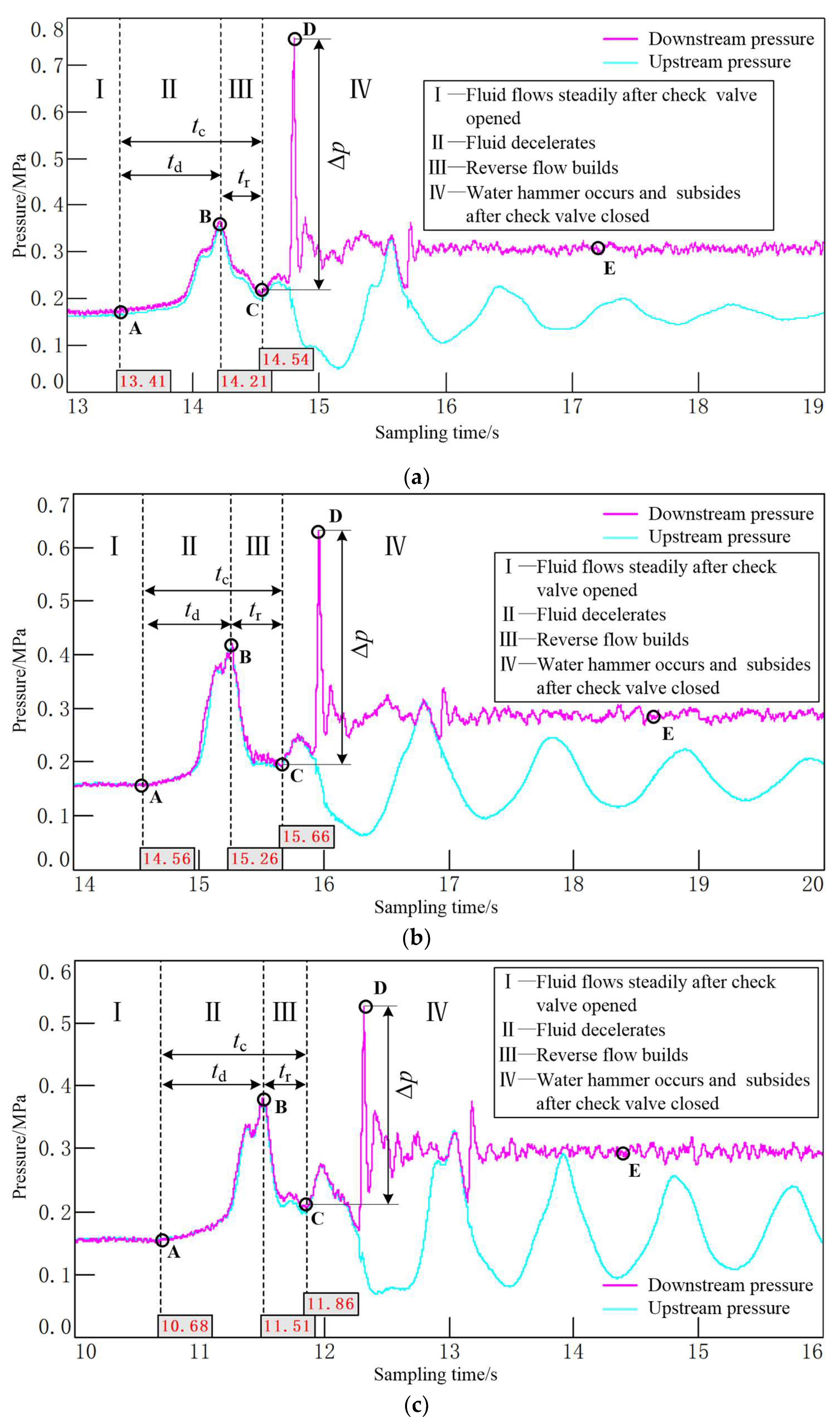
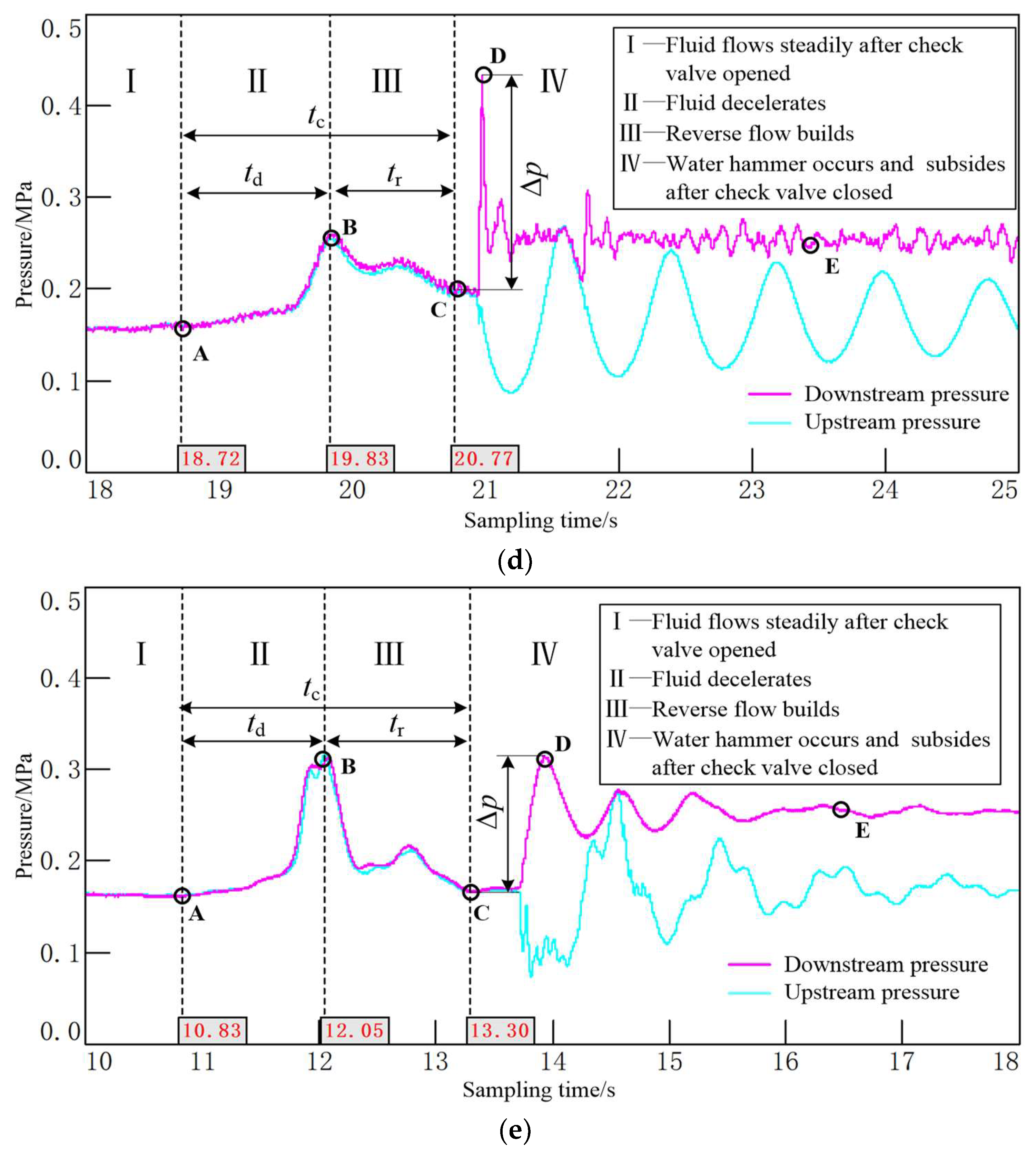
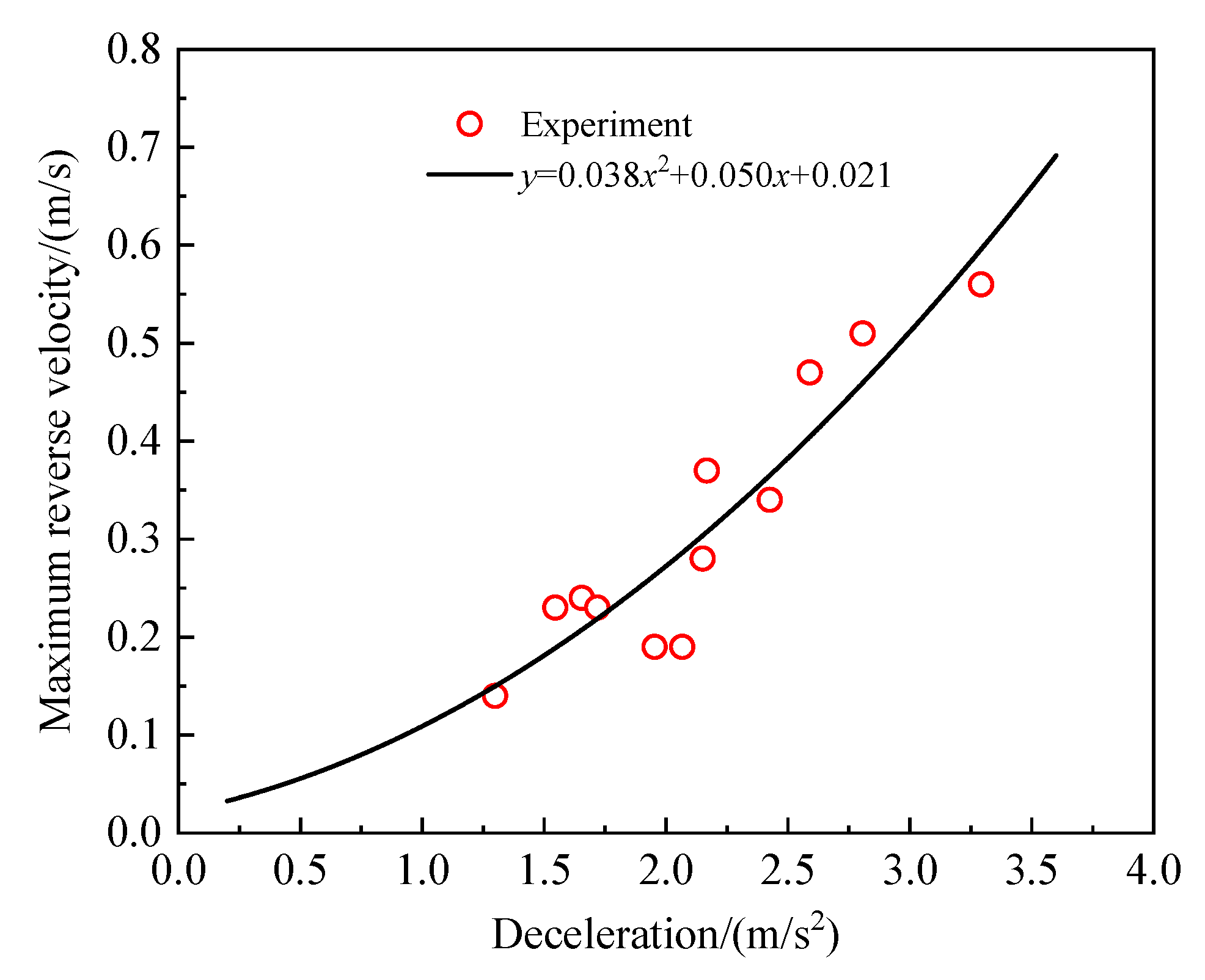
| Experimental Instruments | Parameters | Values |
|---|---|---|
| High water pool | Volume | 24 m3 |
| Height from the tested valve | 20 m | |
| Centrifugal pump | Rated head | 40 m |
| Rated flowrate | 684 m3/h | |
| Pressure sensor | Range | −0.1–1.5 MPa |
| Accuracy | 0.25% | |
| Electromagnetic flowmeter | Specification | DN300 |
| Range | 0–1000 m3/h | |
| Accuracy | 0.21% | |
| LMS data acquisition system | Sampling frequency | 6400 Hz |
| Digital-to-analog conversion | 24 bits | |
| PIV particle image velocimetry system | Pulse frequency | 15 Hz |
| Exposure duration | 400 µs | |
| The time interval | 350 µs |
| No. | Q0/(m3/h) | td/s | Δp/MPa | dv/dt/(m/s2) | vR/(m/s) |
|---|---|---|---|---|---|
| 1 | 403 | 1.22 | 0.14 | 1.30 | 0.14 |
| 2 | 464 | 1.18 | 0.23 | 1.55 | 0.23 |
| 3 | 467 | 1.11 | 0.24 | 1.65 | 0.24 |
| 4 | 485 | 1.11 | 0.23 | 1.72 | 0.23 |
| 5 | 472 | 0.95 | 0.19 | 1.95 | 0.19 |
| 6 | 473 | 0.90 | 0.19 | 2.07 | 0.19 |
| 7 | 443 | 0.81 | 0.28 | 2.15 | 0.28 |
| 8 | 496 | 0.90 | 0.37 | 2.17 | 0.37 |
| 9 | 512 | 0.83 | 0.34 | 2.43 | 0.34 |
| 10 | 461 | 0.70 | 0.47 | 2.59 | 0.47 |
| 11 | 571 | 0.80 | 0.51 | 2.81 | 0.51 |
| 12 | 561 | 0.67 | 0.56 | 3.29 | 0.56 |
Publisher’s Note: MDPI stays neutral with regard to jurisdictional claims in published maps and institutional affiliations. |
© 2022 by the authors. Licensee MDPI, Basel, Switzerland. This article is an open access article distributed under the terms and conditions of the Creative Commons Attribution (CC BY) license (https://creativecommons.org/licenses/by/4.0/).
Share and Cite
Chang, Z.; Jiang, J. Experimental Investigation of the Steady-State Flow Field with Particle Image Velocimetry on a Nozzle Check Valve and Its Dynamic Behaviour on the Pipeline System. Energies 2022, 15, 5393. https://doi.org/10.3390/en15155393
Chang Z, Jiang J. Experimental Investigation of the Steady-State Flow Field with Particle Image Velocimetry on a Nozzle Check Valve and Its Dynamic Behaviour on the Pipeline System. Energies. 2022; 15(15):5393. https://doi.org/10.3390/en15155393
Chicago/Turabian StyleChang, Zhengbai, and Jin Jiang. 2022. "Experimental Investigation of the Steady-State Flow Field with Particle Image Velocimetry on a Nozzle Check Valve and Its Dynamic Behaviour on the Pipeline System" Energies 15, no. 15: 5393. https://doi.org/10.3390/en15155393
APA StyleChang, Z., & Jiang, J. (2022). Experimental Investigation of the Steady-State Flow Field with Particle Image Velocimetry on a Nozzle Check Valve and Its Dynamic Behaviour on the Pipeline System. Energies, 15(15), 5393. https://doi.org/10.3390/en15155393





